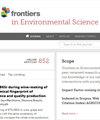调查从潮间带沉积物和漆蛤中提取的Cyanox®53的生态学和毒理学意义
IF 3.3
3区 环境科学与生态学
Q2 ENVIRONMENTAL SCIENCES
引用次数: 0
摘要
我们研究了在不列颠哥伦比亚省(BC)布拉德湾(Burrard Inlet)七个海滩的沉积物和漆蛤中发现的微塑料 Cyanox®53 对生态和毒理学的影响。利用嵌入在估算程序界面 (EPI) Suite™ 中的模拟模型,对 Cyanox®53 的潜在持久性、生物累积性和毒性进行了评估,以评估在含有这种污染物的沉积物上觅食的漆蛤所面临的风险。此外,我们还使用了一个生物能模型,该模型以列入蓝名单的海凫物种为基础,估算了越冬海鸟每天摄入Cyanox®53(单位体重)的风险。我们的研究结果表明,从伯拉德湾(Burrard Inlet)采集的漆蛤平均每只积累了 0.46 个 Cyanox®53 颗粒,根据生物能模型,冲浪海鸟每天可能从觅食的漆蛤中摄入 78 个(雄性)至 83 个(雌性)Cyanox®53 颗粒。EPI Suite™ 预测 Cyanox®53 具有持久性,但不太可能像 "传统 "化学品那样发生生物累积。此外,由于 EPI Suite™ 中模型的可变性和局限性,对 Cyanox®53 对鱼类、大型水蚤和绿藻等水生生物替代物的潜在急性和慢性毒性的估计并不确定。为充分了解Cyanox®53的潜在风险,有必要进行进一步调查。本文章由计算机程序翻译,如有差异,请以英文原文为准。
Investigating the ecological and toxicological significance of Cyanox®53 recovered from intertidal sediments and varnish clam
We examined the ecological and toxicological implications of the microplastic, Cyanox® 53, found in sediments and varnish clams across seven beaches in Burrard Inlet, British Columbia (BC). Using the simulation models embedded within Estimation Programs Interface (EPI) Suite™, the potential persistence, bioaccumulation, and toxicity of Cyanox® 53 was assessed to evaluate the risk to varnish clams foraging on sediment containing this contaminant. Moreover, we used a bioenergetic model, based on the blue-listed surf scoter species, to estimate the risk of daily ingestion of Cyanox® 53 per body weight in overwintering seabirds. Our findings indicate that varnish clams collected from Burrard Inlet accumulate on average 0.46 particles of Cyanox® 53/clam, and based on bioenergetic modeling, results in surf scoters potentially consuming 78 (for males) to 83 (for females) pieces of Cyanox® 53 daily from foraged varnish clams. EPI Suite™ predicted Cyanox® 53 to be persistent, however, unlikely to bioaccumulate as a “traditional” chemical. Furthermore, the estimation of potential acute and chronic toxicity of Cyanox® 53 to aquatic organism surrogates, such as fish, Daphnia magna , and green algae, was inconclusive due to model variability and limitations within EPI Suite™. To fully understand the potential risks of Cyanox® 53 further investigation is warranted.
求助全文
通过发布文献求助,成功后即可免费获取论文全文。
去求助
来源期刊

Frontiers in Environmental Science
Environmental Science-General Environmental Science
CiteScore
4.50
自引率
8.70%
发文量
2276
审稿时长
12 weeks
期刊介绍:
Our natural world is experiencing a state of rapid change unprecedented in the presence of humans. The changes affect virtually all physical, chemical and biological systems on Earth. The interaction of these systems leads to tipping points, feedbacks and amplification of effects. In virtually all cases, the causes of environmental change can be traced to human activity through either direct interventions as a consequence of pollution, or through global warming from greenhouse case emissions. Well-formulated and internationally-relevant policies to mitigate the change, or adapt to the consequences, that will ensure our ability to thrive in the coming decades are badly needed. Without proper understanding of the processes involved, and deep understanding of the likely impacts of bad decisions or inaction, the security of food, water and energy is a risk. Left unchecked shortages of these basic commodities will lead to migration, global geopolitical tension and conflict. This represents the major challenge of our time. We are the first generation to appreciate the problem and we will be judged in future by our ability to determine and take the action necessary. Appropriate knowledge of the condition of our natural world, appreciation of the changes occurring, and predictions of how the future will develop are requisite to the definition and implementation of solutions.
Frontiers in Environmental Science publishes research at the cutting edge of knowledge of our natural world and its various intersections with society. It bridges between the identification and measurement of change, comprehension of the processes responsible, and the measures needed to reduce their impact. Its aim is to assist the formulation of policies, by offering sound scientific evidence on environmental science, that will lead to a more inhabitable and sustainable world for the generations to come.
 求助内容:
求助内容: 应助结果提醒方式:
应助结果提醒方式:


